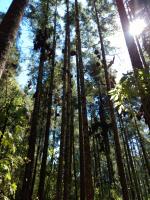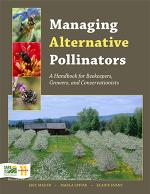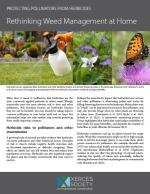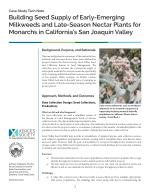As a science-based organization, the Xerces Society produces dozens of publications annually, all of which employ the best available research to guide effective conservation efforts. Our publications range from guidelines for land managers, to brochures offering overviews of key concepts related to invertebrate conservation, from books about supporting pollinators in farmland, to region-specific plant lists. We hope that whatever you are seeking—whether it's guidance on making a home or community garden pollinator-friendly, advice on developing a local pesticide reduction strategy, or detailed information on restoring habitat—you will find it here!
Find Publications
Use the search functions to sort by publication type (books, guidelines, fact sheets, etc.), location, and/or subject (agriculture, gardens, pollinators, pesticides, etc.).
Watch monarchs flutter among oyamel fir trees in Santuario Piedra Herrada, Mexico.
Agroforestry Note #34, General #8 [Agroforestry Notes, February 2007]
This fact sheet from the USDA National Agroforestry Center provides an overview of ways to enhance landscapes to support native bees.
Habitat Installation Guide
These region-and state-specific guidelines provide in-depth practical guidance on how to install and maintain nectar- and pollen-rich habitat for pollinators in the form of wildflower meadow plantings/conservation cover (NRCS Conservation Practice 327) that provide nectar and pollen throughout the growing season, and nesting habitat for bees in the southeast, focused on Florida.
How to Create Habitat for Pollinator Insects on Golf Courses
These guidelines are focused on providing habitat for pollinator insects, primarily native bees. Making Room provides information on the natural history and importance of native bees, and offers practical advice on how to provide flower-rich areas and nesting sites on golf courses. This is supported by lists of relevant reading, helpful organizations, and Internet resources.
There are more than 3,600 species of native bees in North America. Together they form the most important group of pollinators. This fact sheet gives information on how to provide nest sites for native bees, including nesting blocks and bare ground for solitary-nesting bees, and nesting boxes for bumble bees.
39 species of plants native to Delaware that provide pollen, nectar, and, in some cases, nesting sites to native bees.
A Handbook for Beekeepers, Growers and Conservationists
This first-of-its-kind, step-by-step, full-color guide provides information on rearing and managing bumble bees, mason bees, leafcutter bees and other bee species that provide pollination alternatives to the declining honey bee. Written by Eric Mader of the Xerces Society Pollinator Conservation Program; Professor of Entomology Marla Spivak; and Elaine Evans, author of “Befriending Bumble Bees,” the book includes expert information on the business and biology of pollination and how-to guidance on raising the alternative bee species.
These guidelines provide instructions for establishing small pollinator meadows.
A Scientific Review of Causes, Consequences, and Management Alternatives
This report outlines key aspects of bark beetle outbreaks, their relationship to fire risk, and presents alternatives to large scale logging practices. Additionally, it suggests that government efforts to stem the infestation of insects in forests across the American West may be ineffective and are unlikely to mitigate future infestation or decrease wildfire risk. In fact, government efforts to cull and control insect outbreaks, which play “an important role in the development and maintenance of forest,” could have significant short-term and long-term impacts on national roadless forests, according to the report. Currently, state and federal agencies continue to spend millions to battle spreading mountain pine beetles and other insects across western states. In recent years, mountain pine beetles have infested millions of acres in Colorado, Wyoming and Montana.
Agroforestry Note #33, General #7 [Agroforestry Notes, August 2006]







